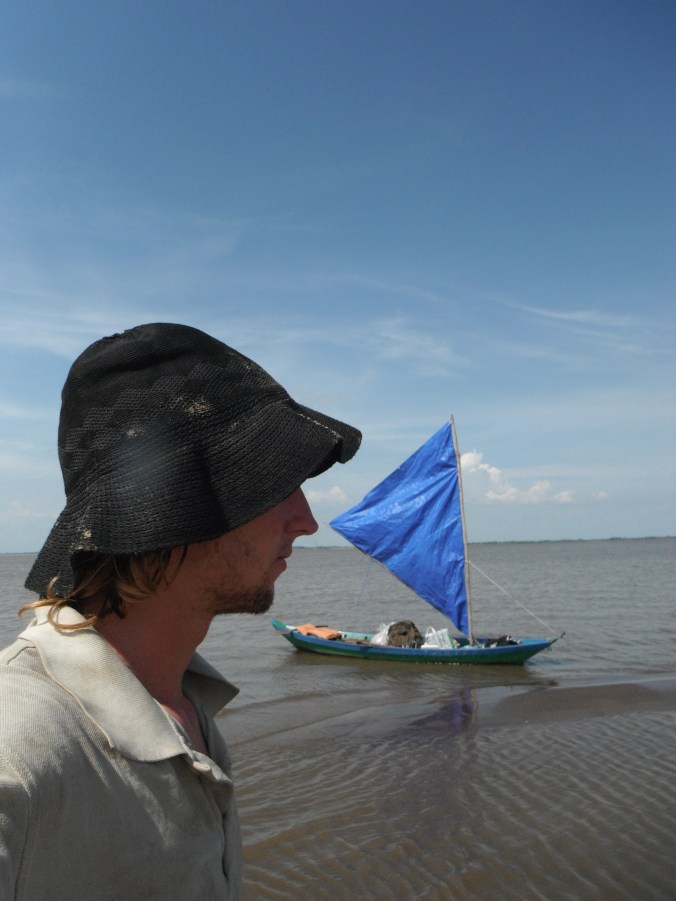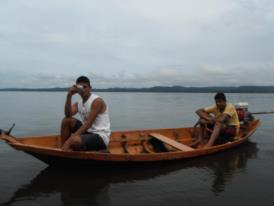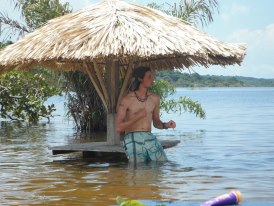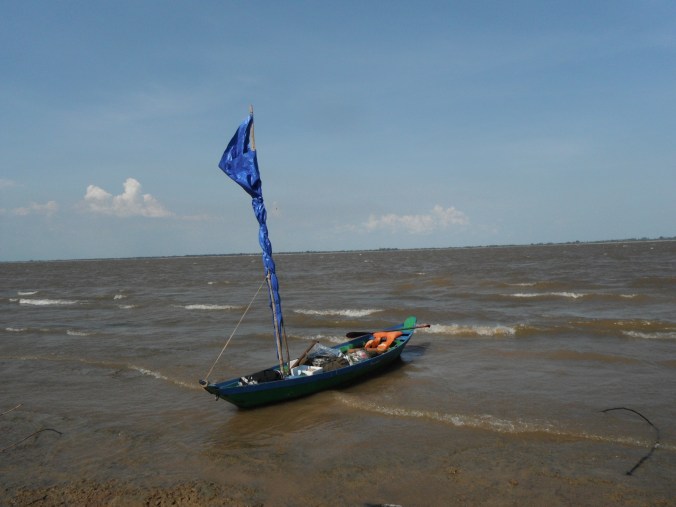The tropical sun has chapped my lips once again, and my hands are covered with dry, peeling calluses and cuts in various stages of healing from the pressure and friction of the sail line in my hand and the rough wood of my paddle, which I use to force my boat to slide sideways through a crosswind or keep her sailing straight with an overenthusiastic tailwind on the holy Amazon River of Brazil. The river dolphins take a special interest in my craft, for some reason; nearly every time I round a point or make a decently long crossing to or from some island or another a pod of the strange, pinkish creatures is never far away, the sound of the air shooting from their blowholes ringing out loudly and suddenly, sometimes causing me to jump a little in surprise – but never fear, for the river dolphin is docile and navigates superbly through the dark, murky waters of the Amazon by sonar and thus the probability of an accidental ramming and consequential overturning of my boat by dolphin is extremely low, unlikely, even impossible.
The days the wind favors me I spend sitting in the back of my canoe, both hands on the paddle, steering, and with the guiding rope of the sail wrapped around the handle and a few of my fingers. There I sit for hours, watching boats pass me by – boats of all sizes and shapes. Canoes, like mine, paddled or powered by small motors that look like weed eaters with propellers instead of string on the ends (known locally as rabetas), by fishermen tending to their drifting gill nets; old, weathered faces, aged well before their time by hard lives and the sun. The wrinkles are like canyons that start in foreheads and the corners of eyes and continue snaking down naked, leathery backs like a map of the river itself, until they disappear under pairs of old canvas cargos or barely recognizable Nike basketball shorts, all bleached almost white by years of sun and rough hand washing with bar soap. The wrinkled faces give me long, non-comprehending stares as I sail quietly by and squint at the big fish in the bottoms of their boats; some wave, some grin to show a few haggard teeth, but most just stare and stare and stare until I’m too far away to see their stares anymore but I can still feel them. I wonder about their lives and their years on the riverside, the fish they’ve caught, the ones that got away. I wonder about the loneliness they must feel, their families, loved ones, here and gone. I wonder who has wronged these men, taken advantage, stolen, broken trust. I wonder what makes those faces smile, I mean really smile, and I wonder about happiness in general, theirs and mine.
Medium sized boats five to ten metres long are called bajaras and they are powered by a motor that sits in the bottom of the back of the boat and makes a distinct pop-pop-pop-popping sound that you hear long before you actually see the boat. Usually there is a family, or a group, inside. The women lounge and knit in hammocks tied to the supports of the short roof that covers the majority of the craft while the men mend nets and hunch over masses of tangled line that seem impossible to undo, working steadily and without pause, and the piles of smooth, coiled line grow inexplicably. The same wrinkled faces stare back at me, the fishermen of the Amazon River whose dark brown eyes seem as cloudy and mysterious as the waters of the river herself.
Speedboats, or voeaderas carry people from the cities by at high speeds, sometimes business travelers, sometimes families of city people from Santarém, and sometimes drunk groups of loud young men who blast tecno-breggae music with the bass turned up too much and leave a meter –high boat wake and empty beer cans behind them. They are too busy having fun to notice me, creeping along near the bank and counting birds. I am also too busy to notice them, with the massive waves they’ve sent barreling towards me.
Medium-sized passenger boats (barcos da linha) pass at regular intervals, usually loaded well over the legal number of passengers permitted by the Brazilian Navy. Hammocks are hung in every available space and angle, and everybody on board looks like they’d rather just arrive where they were going and get off the damn boat already. The large passenger ships, or naveos, travel for days at a time, from distant cities like Belém to other distant cities like Manaus. They have many floors and are made of metal. The top floor always seems to host a bar and dance floor and lights. These passengers seem less miserable than the others on the smaller barcos da linha.
Then, always in the distance, massive ocean freighters from foreign lands around the world trudge up and down the mighty Amazon as if she were nothing more than another sea current, humming deeply and sinisterly like UFO’s, and about as incongruous. They push up a wall of water off their sterns that is harmless while away from shore but once collides with the riverbanks regularly sinks poorly docked canoes and even bajadas. I can never see faces aboard; I wonder if they see me, and if they stare, too. Or perhaps, as I sometimes suspect, they are merely controlled by soulless robots as bleak and efficient as the ships they pilot.
Whenever the wind does not favor me I am forced to paddle, sticking as close to the shore as possible and maneuvering my vessel through the maze of waves and countercurrents the river throws at me. This at times is so tedious, draining, and above all slow that it is actually both easier and faster for me to leave the canoe and wade through the shallows while pulling my canoe bodily along behind me. This, however, is a risky business due to the large number of fresh water stingrays the Amazon River is home to, and the fact that the shallows are favorite hangouts for young, fresh-barbed specimens.
I had fever for four days, poorly-timed strep throat is all, and the only solution that existed in these waters was to simply tough it out. It really wore on me sometimes, though; in the evenings I sometimes hadn’t even the energy to cast my net I paid R$60 for in Santarém, and if I somehow found strength for that, build a fire to cook the fish – more heat. I existed for three days on just farinha de mandioca (crushed-up dried mandioc root) and lukewarm river water. I remember lying in a huddled mass of malaise under my sail on the sandbar of some lonely island one night as an uncommon dry season storm howled away over me long into the wee hours of the morning; I tossed and turned and shivered through feverish dreams, frightening and confusing, and woke up the next morning tangled up in my sail and a sandy old sheet, wondering frantically if I was still sane as I crunched the hard, flavorless granules of farinha and sucked down rainwater from puddles that had formed on the sandbar during the night.
But like all things the fever ran out, and I was back on my feet and healthy enough to accept the offers of beers from impressed locals in the city of Óbidos, many whom had seen my during the days I spent sailing from Santarém and couldn’t believe I had come all that way, though I told them it was only 118 kilometers. But sailing up the Amazon River in a canoe – that’s not something everybody does.
Many of you are probably wondering where all this is coming from – what about the raft, what about Macapá, and all that stuff I was up to the last time I wrote here? Well, I built the raft, yes. It took three tries but I finally built a solid, pretty raft in the city of São Luís do Tapajós that supported my weight and that of my things and was slightly maneuverable. Granted, locals helped me with the heavy lifting, since each one of the six massive samaoma trees I cut down with my tiny hatchet weighed a good 500 lbs. But I finished her, and just after celebrating Carneval I floated alone down the Tapajós River as the majority of the population of the riverside community stood on the riverbank and watched me go, sending me off with solemn waves in the early morning mist.

My raft. For photos of the inside go to this reporter’s blog who interviewed me in Itaituba: http://blogdojuniorribeiro.blogspot.com.br/2012/03/o-americano-patrick-falterman-de-21.html
I floated to Itaituba in two days, stayed there for a week, tried to leave again but found that the raft was sinking due to it ramming the dock too much when boat wake hit it, so I lashed a mess of boyant fat old banana trees under her which seemed to do the trick. And so I continued to float downriver, weathering many angry, enormous March rainy season storms and fearing for my life more than a few times when the roiling waters of the Tapajós seemed an inevitable and very permanent part of my immediate future.
I attracted massive attention, due to the strange appearance of my craft, and I believe more photos were taken of her by cell phones than were taken of me my entire life. I spent many long afternoons lounging on my paddle deck, smoking my pipe or stash of pot, grinning and tickled pink that this was actually working out all right.
At night I tied up the raft to some tree or another, tied my black plastic doors shut, and passed out on the old damp foam mattress a caring soul had given me in São Luís, (from which I got the name, The Wet Mattress) which I had spread out on the inside of the little house. The next morning I’d be back on the river, early as can be. Sometimes I stopped in small communities, where I was treated well and enjoyed unlimited food and positive attention for my brave endeavor and interesting transportation.
After awhile on the river – probably about two weeks – I arrived to Averio, which would end up being the final resting place for my raft. It wasn’t my fault, or anyone’s, really – the river simply wouldn’t allow for more raft travel after Averio, due to the fact that the Tapajós River goes from 1-2 kilometers wide to 15-20 kilometers wide. The current almost stops, or I think just flows very deep – and if there’s no current, the raft doesn’t go. Add this to a prevailing headwind and you’ve got impossible conditions for the raft I had built. So I scrapped her.
Undeterred, I spent a good two months in Aveiro, devising a way to get a canoe. In the end I traded my small laptop for one – something I thought was a pretty good trade at the time, but looking back on it now I see that I could have probably gotten enough money for that laptop to buy four canoes, if I would have just known better. Live and learn.
I celebrated my 22nd birthday in Averio, made friends, got drunk a little too often, and left the city with a similar ceremonial departure as São Luís do Tapajós, with at least 200 people lined up on the bank to see me off on my paddling journey to Santarém in my newly painted and remodeled boat, which I had dubbed C/R Muiraquitã – after a traditional Indian frog amulet of the same name.
The canoe proved much more maneuverable and enjoyable to pilot than the raft – though the Wet Mattress was indisputably more comfortable, even if the mattress was a little damp – and I had a lovely time following the Tapajós National Forest for 160 km to Santarém. I stopped in a total of 7 different fishing communities along the way and learned how to roast giant river turtles and how to break their shells to get at the best meat, and where to leave gill nets during the rainy season. Total time to Santarém was about fifteen days, including the three days I spent in the then-flooded beach town of Alter-do-Chão, which was seasonally beachless.
It’s worth noting that all the paddling I did from Alter-do-Chão to Santarém I was forced to do at night, since the turn east forced a mighty strong headwind upon me that was impossible to paddle into. After a few close calls involving boats almost destroying me in the darkness, I arrived to Santarém exhausted to the extreme but also extremely pleased with myself. This was sometime in mid-May.
After the problems the wind had given me between Alter-do-Chão and Santarém I was about ready to forget the idea of heading to Macapá – downriver but right smack into a powerful prevailing headwind that had been kicking my ass for three days. And that would go on for another 1.500 kilometers. And so a slight change in plans was made: now I would be going up the Amazon River – and I’d be sailing, so that wind would be helping me instead of hurting me. The plan was to stay in Santarém for a few weeks, get some money together to buy more gear and build a sail and then head up river with the whole dry season ahead of me.
What actually happened was I stayed in Santarém for about five months in total, most of that time which I spent mingling with all types of people on the streets of the city, drinking heavily, sleeping with loose women, sleeping with tight women, sleeping with in-between women, smoking lots of pot, and working many different odd jobs for canoe cash. These included handing out pamphlets for the dentist, selling bags of green beans in the vegetable market out of a wheelbarrow, washing dishes, cutting and cooking meat at a high-end churrascaría (Brazilian Bar-B-Q – much better than the American variety), scavenging old beer cans, collecting money for the restroom at the soccer stadium during games, and of course playing music.

Lençóes Maranhenses. They’re beautiful the first two days. After that they just give you nightmares.
I also took a 40-day “break” from the Amazon, in the form of me hitchhiking to the neighboring state of Maranhão, where I smoked a lot more weed than usual and walked across a 155.000 hectare area of sand dunes and freshwater lakes known as the Lençóes Maranhenses with a good old crazy from Chile named Eduardo I met on a drunken blurry night in the city of Barrerinhas – where I had been hanging out playing music with a bunch of Brazilian drum hippies. The roughly 80 km took five days, since we smartly decided we didn’t need no guide, and that was 80 km, up and down and up and down these ridiculous piles of sand under the equatorial sun – and of course we became very lost and delirious and slightly emaciated from lack of food, and probably both hallucinated about killing the other one and eating him – but as usual it was all worth it in the end, and I hitchhiked back to Santarém with a new friend and a lot of new stories to tell the grandchildren I’ll probably never live long enough to meet or indirectly create.

Me after killing and eating my freind Eduardo – I mean, after finishing the crossing and remaining good freinds with Eduardo
So yeah. That’s what I’ve been up to the past six months, instead of writing in this blog, which is extremely time consuming and requires the laptop I traded for a canoe. Now I’m sailing up the Amazon river in my laptop. I’m going to Manaus, I guess, but who knows where I’ll end up.
Greetings from Óbidós, droogies. I know a lot of you enjoy reading my blog posts and I’m sorry I haven’t written as much lately, but to be honest, I don’t have the focus nor the energy nor the resources to keep writing here at the level that I was doing before anymore. This blog is not dead, I’ll still post from time to time about interesting tidbits, but as for the rest, you’ll just have to wait until I publish my book. Someday. Don’t hold your breath. And as for those of you who were living vicariously through my writings, I’m flattered, thank you, really – but here’s an idea: if you enjoyed so much reading about adventures, think how much you’ll enjoy going out there and actually having some for yourself! Go for it, Sparky! I’m behind you all the way! In spirit, of course…
Now that I’ve gotten this out of the way, I’m off to drink whiskey and ride motorcycles for the weekend along a nearby dry riverbed with 18.000 other drunk Brazilians on motorcycles. No I will not explain myself any further, and I really don’t think I need to. And once I get back, my canoe and the rest of the Amazon River from here to Manaus will be waiting…
Peace. I’ll post again…whenever.
-Patrick











It’s been a while and we’re all glad to hear from you.
And I totally understand your blogging/writing frustrations. Like I’ve been trying to update my blog( https://wfatp.wordpress.com/ ) for months. As you can see the last post was in the beginning of March. Just so much stuff I wanna say that I have trouble letting it out. And this is regarding shit that happened in February. :-( Right now the update is just floating around as an approximately 15,000 word draft not ready to be publically released. But if you want I can email it to you.
Much like yourself I just don’t have the energy. Esspecially annoying is the fact that few people read my blog and when you consider the amount of work each post is to put together the main reason I’m still trying to finish the post at this point in time is because as of like February it has you following it.
I’m also sorry I stopped midway through the chronological reading of your blog though I have every intent on finishing. Just these days I’m so burnt out I’ve largely been staying away from the blogosphere and I simply can’t concentrate on much of anything. Also the epicness of your deeds is such that just reading them makes me wanna cry because I’m not out there doing awesome shit all day every day like you are. I just can’t handle reading this blog at this point in time.
Anyway I’m glad that unlike me you’ve been out there kicking ass. Best of luck on your current and future endeavours. Smile like a saint. Fuck like a pirate.
Hope you get the post finished – you can email it to me if you want but I’d rather read it once you’ve finished. What have you been doing lately? I ceartinly don’t do awesome shit all day every day, by the way. I still have many quiet boring days. Life’s like that – but at least once every couple of weeks you’ve gotta get out there and do something crazy or life in general starts to suck. Remember that.
-MN
Thanks for the update… Totally understand about not wanting to keep the blog going, I think like 5 people read mine (100% of which is family) for all the effort of writing 14,000 word posts it’s not much return.
Since this might be your last post I just wanted to say thanks! Your crazy adventure has inspired me to change my path through life considerably by showing it is possible to go out and do these things… So rather than do yet more school I’m going for adventure having already driven my ’85 Toyota to the Arctic (9500km in 2 weeks, 1500km of gravel on tundra) and I’ve got some things lined up to work on a land trust in Paraguay next year… who the hell knows that the future holds
So thanks again, and thank you again for the amazing amount of effort you put into documenting your experiences so far, I wish you the best in your explorations! I am sure your experiences will inspire others…
Hey man, sounds great! I’m glad to have inspired. If you end up in Paraguay don’t throw out the idea of a trip to the Amazon, you can have a few beers on me!
-MN
Thank you for this post!
I was really worried about the long delay and feared the worst…glad to hear you’re well!
Don’t worry man…if I die I’ll be sure to put up a post about it right away ahahaha :P
-MN
Patrick I have decided to follow. You’re writing is very descriptive. It seems obvious you enjoy it. I particularly enjoyed the picture you paint of the fishermen.
sailing up the river in your laptop haha ;)
I don’t regret the trade haha